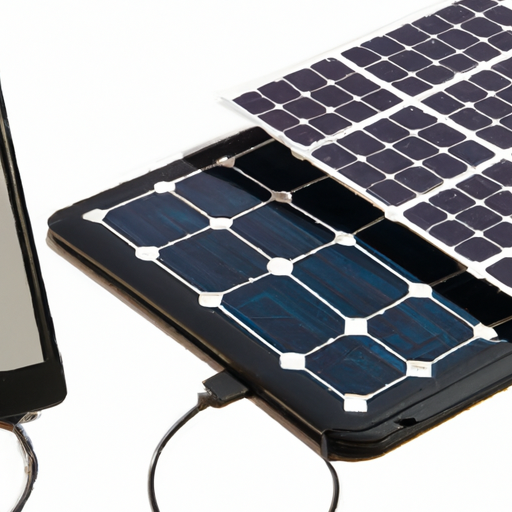

Have you ever wondered if you can use portable solar panels to charge multiple devices at the same time? Well, I’m here to tell you that the answer is a resounding yes! With the advancements in technology, portable solar panels have become more efficient and powerful, allowing you to harness the sun’s energy and charge your devices wherever you go. Whether you’re camping in the wilderness or traveling on a long road trip, portable solar panels can be a game-changer.
Now, let’s dive into the details. Portable solar panels are designed to convert sunlight into electricity, which can then be used to charge various devices such as smartphones, tablets, cameras, and even power banks. The best part is that you can charge different types of devices simultaneously, thanks to the multiple output ports that many portable solar panels come with. These panels usually have USB ports, DC ports, and sometimes even AC outlets, allowing you to connect different devices simultaneously and charge them efficiently.
In our upcoming article, we will explore the different types of portable solar panels available on the market, their features, and how they can be used to charge different devices simultaneously. Whether you’re an outdoor enthusiast, a frequent traveler, or simply looking for a sustainable way to charge your devices, you won’t want to miss out on this valuable information. Stay tuned to learn more about the exciting world of portable solar panels and how they can power up your devices while on the go.


Introduction
Definition of portable solar panels
Portable solar panels are compact and lightweight devices that harness the power of the sun to generate electricity. They are designed to be easily carried and set up, making them ideal for outdoor activities, emergencies, and off-grid living. These panels consist of photovoltaic (PV) cells that convert sunlight into usable energy, which can then be used to charge various electronic devices.
Advantages of using portable solar panels
The use of portable solar panels offers several advantages. Firstly, they provide a renewable and sustainable source of energy, reducing reliance on traditional fossil fuels. Secondly, they are convenient and portable, allowing you to generate electricity wherever you are. This is particularly useful in outdoor activities, emergencies, and situations where access to power sources is limited. Finally, using portable solar panels can save you money in the long run, as you won’t have to rely on expensive electricity from the grid or constantly replace batteries.
Growing popularity of portable solar panels
In recent years, there has been a significant increase in the popularity of portable solar panels. This can be attributed to several factors. Firstly, advancements in technology have made portable solar panels more efficient and affordable. This has made them more accessible to a wider range of people, including outdoor enthusiasts, campers, and individuals living in remote areas. Additionally, there is a growing awareness of the importance of sustainability and reducing our carbon footprint. Portable solar panels provide an eco-friendly alternative to traditional sources of electricity. As a result, more and more people are embracing this renewable energy solution.
Types of portable solar panels
Monocrystalline solar panels
Monocrystalline solar panels are made from a single crystal structure, typically silicon. They are known for their high efficiency, as they have a uniform appearance and are made from a pure crystalline structure. Monocrystalline solar panels are often more expensive than other types, but they offer a higher energy conversion rate, making them ideal for situations where space and weight are limited.
Polycrystalline solar panels
Polycrystalline solar panels are made from multiple crystal structures, resulting in a less uniform appearance. They are less expensive to produce than monocrystalline panels, but they have a slightly lower efficiency. However, polycrystalline panels still provide a reliable source of energy and are suitable for most portable solar panel applications.
Thin-film solar panels
Thin-film solar panels are made by depositing a thin layer of photovoltaic material onto a substrate, such as glass or metal. They are lightweight and flexible, allowing for easy installation and portability. However, thin-film solar panels have a lower efficiency compared to crystalline panels, meaning they require more surface area to generate the same amount of power. Despite this, thin-film solar panels are popular for their versatility and adaptability in various applications.
Compatibility with different devices
Portable solar panels can be used to charge a wide range of devices. Here are some examples of the types of devices that can be charged using portable solar panels:
Smartphones and tablets
One of the most common applications for portable solar panels is charging smartphones and tablets. These devices have become an essential part of our daily lives, and having a reliable source of power while on the go is crucial. With the right solar panel and charging cables, you can easily keep your devices powered up no matter where you are.
Laptops and portable computers
For individuals who work remotely or travel frequently, charging laptops and portable computers can be a challenge. Traditional power outlets may not always be available or convenient to access. Portable solar panels provide a convenient and sustainable solution for keeping your devices charged and allowing you to stay productive on the go.
Cameras and GoPros
Photographers and adventure enthusiasts often rely on cameras and GoPros to capture their experiences. However, these devices require a constant source of power to ensure they don’t run out of batteries at critical moments. Portable solar panels can provide a reliable and renewable source of energy to keep your cameras and GoPros charged throughout your outdoor adventures.
Portable fans and coolers
While not electronic devices in the traditional sense, portable fans and coolers can greatly enhance comfort during outdoor activities. However, these devices often rely on batteries or connection to a power source. Portable solar panels can enable you to enjoy the cool breeze and keep your drinks cold without worrying about running out of power.
Outdoor lights and lanterns
When camping or spending time outdoors, having adequate lighting is essential for safety and convenience. Portable solar panels can be used to charge outdoor lights and lanterns, ensuring you have a reliable source of light during your outdoor adventures. These solar-powered lights are eco-friendly and eliminate the need for batteries or fuel.


Factors to consider for simultaneous charging
While portable solar panels can charge multiple devices simultaneously, there are several factors to consider to ensure efficient and effective charging:
Power output of the solar panel
Different portable solar panels have varying power outputs. The power output determines how much electricity the panel can generate, which in turn affects the charging speed of your devices. It is essential to choose a solar panel with a power output that matches the power requirements of the devices you intend to charge simultaneously.
Battery capacity of the devices
The battery capacity of your devices also plays a crucial role in simultaneous charging. If the devices have larger battery capacities, they will take longer to charge, especially if the solar panel’s power output is not sufficient. It is important to consider the battery capacity of your devices and ensure that it is compatible with the solar panel’s power output.
Charging ports and connectors
When using a portable solar panel to charge multiple devices simultaneously, it is essential to have the appropriate charging ports and connectors. Some solar panels come with built-in USB ports, while others may require the use of adapters or additional cables. Ensuring compatibility between your devices and the solar panel’s charging ports will ensure a smooth charging experience.
Sunlight availability and panel orientation
The amount of sunlight available and the orientation of the solar panel also affect the charging speed and efficiency. Ideally, the solar panel should be placed in direct sunlight with minimal shading to maximize its power output. Additionally, adjusting the panel’s orientation to face the sun will optimize its performance. It is important to consider the location and positioning of the solar panel to ensure efficient charging.
Benefits of simultaneous charging
Simultaneous charging using portable solar panels offers several benefits:
Convenience for outdoor activities
Whether you are camping, hiking, or engaging in other outdoor activities, having the ability to charge multiple devices simultaneously can greatly enhance convenience. You can keep your smartphones, cameras, and other essential devices powered up, ensuring that you stay connected and can capture memories without worrying about running out of battery.
Optimizing solar panel usage
Simultaneous charging allows you to make the most of your portable solar panel’s power output. Instead of charging devices one at a time, you can charge multiple devices simultaneously, maximizing the use of the available sunlight and reducing the time required to charge each device individually. This optimizes the efficiency of the solar panel and ensures that you have a continuous source of power for your various devices.
Reducing charging time
Simultaneous charging can significantly reduce the overall charging time for your devices. Instead of waiting for each device to charge separately, you can charge them all at once using a multi-port solar panel charger. This is particularly beneficial in situations where time is of the essence, such as emergencies or when you have a limited window of sunlight.
Potential limitations
While portable solar panels offer several advantages for simultaneous charging, there are some limitations to be aware of:
Limited power output
Portable solar panels typically have a limited power output compared to traditional power outlets. This means that the charging speed of your devices may be slower compared to charging them directly from a power outlet. It is important to manage your expectations and plan accordingly, especially when charging devices with larger battery capacities.
Inconsistent charging performance
The charging performance of portable solar panels can be affected by factors such as cloud cover, shading, and the angle of the sun. In certain weather conditions or locations with limited sunlight, the charging speed may be reduced or inconsistent. It is important to be aware of these factors and adjust the positioning of the solar panel when necessary to ensure optimal charging performance.
Device compatibility issues
Not all devices are compatible with portable solar panels. Some devices may require a higher power input or have specific charging requirements that may not be met by the solar panel. It is important to check the specifications of your devices and ensure compatibility before attempting simultaneous charging.
Tips for efficient simultaneous charging
To maximize the efficiency of simultaneous charging with portable solar panels, consider the following tips:
Prioritize devices with lower power requirements
When charging multiple devices simultaneously, prioritize devices with lower power requirements. This will ensure that they are charged quickly and efficiently, leaving more power available for devices that require higher power inputs. It is also a good idea to fully charge devices with higher power requirements individually before attempting simultaneous charging.
Utilize multi-port solar panel chargers
Invest in multi-port solar panel chargers that are specifically designed for simultaneous charging. These chargers allow you to connect multiple devices to a single solar panel, making it easier to charge multiple devices at once. Ensure that the charger has the necessary charging ports and connectors for your devices.
Maximize sunlight exposure
Position your portable solar panel in a location where it can receive maximum sunlight exposure throughout the day. Avoid shading from trees, buildings, or other objects that may obstruct sunlight. Additionally, adjust the panel’s angle based on the sun’s position to optimize its performance.
Monitor and manage battery levels
Keep an eye on the battery levels of your devices during simultaneous charging. This will allow you to prioritize devices that need immediate charging and manage the power distribution accordingly. It is also important to disconnect fully charged devices to avoid unnecessary power drain.
Real-world scenarios and applications
Portable solar panels can be used in various real-world scenarios and applications:
Camping and outdoor adventures
Portable solar panels are a popular choice for camping and outdoor adventures. They provide a sustainable source of power for charging devices, lighting, and other essential equipment. Whether you are hiking in the wilderness or setting up camp in a remote location, portable solar panels offer convenience and peace of mind.
Emergency situations and power outages
During emergencies or power outages, access to electricity may be limited or unavailable. Portable solar panels can be a lifesaver in such situations, allowing you to charge essential devices like smartphones, radios, and flashlights. Having a reliable source of power can help you stay connected and informed during challenging times.
Off-grid living and traveling
For individuals living off the grid or traveling in remote areas, portable solar panels provide a sustainable and reliable source of power. They allow you to charge devices, power lighting and appliances, and maintain a comfortable living environment without the need for traditional power sources. This makes off-grid living and traveling more feasible and enjoyable.
Remote work and digital nomadism
With the increasing trend of remote work and digital nomadism, portable solar panels have become essential for individuals working remotely. They provide a convenient and sustainable source of power for charging laptops, tablets, and other work-related devices. This allows remote workers to be productive while enjoying the freedom and flexibility of working from anywhere.
Case studies and success stories
The use of portable solar panels for simultaneous charging has been met with positive feedback and success stories. Here are a few examples:
Users’ experiences with simultaneous charging
Many users have reported successful simultaneous charging experiences using portable solar panels. They have praised the convenience, reliability, and sustainability of this charging method. Users have shared their experiences of charging multiple devices, including smartphones, tablets, and cameras, while camping, hiking, or traveling. They have found that simultaneous charging reduces the time spent charging and ensures that all their devices stay powered up.
Notable projects and initiatives
There have been several notable projects and initiatives that highlight the practicality and effectiveness of simultaneous charging using portable solar panels. For example, solar-powered charging stations have been set up in remote areas and disaster-stricken regions, providing communities with access to electricity for charging devices and other essential needs. These projects have demonstrated the potential impact and benefits of portable solar panels in various contexts.
Demonstration of practicality and effectiveness
Various demonstrations and experiments have been conducted to showcase the practicality and effectiveness of simultaneous charging with portable solar panels. These demonstrations often involve charging multiple devices simultaneously, showcasing the charging speed, and the ability of the solar panel to generate sufficient power for all devices. The results of these demonstrations consistently show that portable solar panels can effectively charge multiple devices at once.
Conclusion
Portable solar panels offer a versatile solution for charging different types of devices simultaneously. With advancements in technology and growing demand for sustainable energy sources, portable solar panels have become a popular choice for individuals engaged in outdoor activities, living off the grid, or simply looking for a reliable and eco-friendly charging option. By considering factors such as power output, battery capacity, and device compatibility, you can effectively charge multiple devices using a portable solar panel. Simultaneous charging with portable solar panels offers convenience, optimizes power usage, and reduces charging time. Whether you are camping, experiencing a power outage, or working remotely, portable solar panels provide a practical and efficient solution for keeping your devices powered up. The growing popularity of portable solar panels reflects the increasing demand for sustainable energy solutions in a technology-driven society. Embracing this renewable energy source can make a positive impact on both the environment and your daily life.



